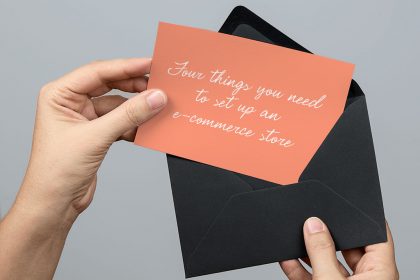41 psychological tricks that can boost your online sales
Do you sell online? Want to increase your conversion rate and rack up more sales? Here are 41 psychological tricks that can boost your online sales.
You can have the best product in the world. You can market it at the right time and perfect price point for your ideal customer. But if you don’t properly understand the psychology of buying, you won’t get the sales you should.
Successful ecommerce websites know all the tiny tricks and tweaks that can help their products fly off their website. And to help you boost your own sales, direct mail marketing experts Romax have shared 41 of them with us.
Their tips are based on key psychological strategies and cover:
- Social proof – we’re easily influenced by peer groups. This is why successful online retailers use the social proof technique.
- Pricing – there are certain pricing triggers that either put people off or cause them to click. However, not all target audiences are the same, so it’s also about finding what does and doesn’t work for the different segments.
- Scarcity, fear of missing out (FOMO) or loss aversion – we are hardwired to fear scarcity. In nature, scarcity means the difference between life and death. As an online retailer, you can take advantage of this psychological factor.
- Site layout and colours – the way your site is laid out can have a dramatic effect on a person’s psychology. These tips will help you get it right.
- Photography and video – the problem with online shopping is that you can’t touch and smell the product. You can, however, artfully recreate that sense of ‘real-world shopping’.
- Closing the sale at the checkout – you’ve laid out your website perfectly, compelled them to place more items in their basket than they need, now for the final hurdle: closing the sale. Many ecommerce websites fail. But you’re not going to.
- Reciprocation and commitment – reciprocation is the idea that if you give something to a prospect they’ll give you something in return (like a sale). Similarly, if you give away something for free with no-strings-attached they’ll tend to feel committed and will actually stay with you. These techniques predate ecommerce, but are still relevant. Make use of them and give your conversion rates a boost.
41 psychological tricks that can boost your online sales
So if you’d love to see your ecommerce profits rise, see how many of these psychological online sales tricks you can adopt.
1) Highlight your bestsellers
If lots of other people want something, we assume it has to be good. We also don’t want to miss out on it. So highlight your bestsellers.
2) Promote your reviews
Ask customers for reviews and testimonials and strategically place them around your website to let potential buyers know you’re liked and trusted.
3) Share quotes on social media
Don’t keep your delighted customers’ emails and reviews to yourself. Share them on social media. You could even design them into simple graphic visuals to make them stand out.
4) Add endorsements from friends
Show your customers what their connections have recently purchased, to encourage them to follow suit.
5) Appeal to their ego
Appeal to people’s sense of identity and place them in a certain social category. Let them know that you consider them to be a discerning, intelligent, stylish buyer. It may encourage them to live up to that impression.
6) Allow a few negative reviews
If all your reviews are glowingly positive, they could look biased or worse, made up. So allow some negative reviews on your site to increase trust. But always make sure you respond to them and are seen to address any criticism – this can help demonstrate that you go our of your way to satisfy customers.
7) Encourage customers to share
Encourage your existing customers to share your content with their network and display these shares in a counter. This adds extra weight to your claims.
8) Use .97 instead of .99
This is an improvement on the left digit effect. Most retailers will use £9.99 to make the customer think it’s cheaper. But as customers get more savvy and shop around, you can get ahead by making it £9.97.
9) Show the price-saving next to the product
To highlight what great value a customers is getting, put the old price next to the new price, and include the percentile saving.
10) Use numerical digits instead of words
Numbers take less time for the brain to process than words. The typical internet user has a low attention span, so it’s important to help make their mind up quickly. Half-price becomes 50%.
11) Offer incentives to buy more
Encourage customers to round up their order to a higher amount. For example, by offering free shipping on orders over £25. They’ll be tempted to add a few more items just to save the shipping fee.
12) Test customer psychology
Test customer psychology with different pricing tables, and go with the one that gets results. Tailor your pricing strategy to your market by finding out what they respond to.
13) Use fewer syllables to make the price appear smaller
The brain associates with the number of syllables with quantity. The more syllables in a price, the more expensive it seems. So three hundred and ninety pounds becomes three-nine-nine.
14) Use the Goldilocks effect
When buying something, most of us are looking for the ‘just right’ option – not too cheap, not too expensive. To help your customers spot this option, place the ideal purchase in the middle. If you have three options, people will tend to go for the middle option.
15) Use the price anchoring technique
This is where you again have three options, but this time you want them to choose the most expensive. The cheapest acts as an anchor. The middle is what they’re after. But the most expensive is better value, because if they spend an extra few pounds they get twice as much.
16) Increase the price on their second visit
If you want to encourage buyers to buy now and not come back later, use cookies and put the price up when they next visit the site. You may not make a sale that time, but at least they know next time to buy something they like quickly.
17) Tell people there are only a few left in stock
Knowing there are only a few left of an item adds urgency to a purchase and makes customers think that if they don’t act now they’ll miss their chance. But don’t lie! You can get around the truth by saying things like ‘only five left at this price’. Then periodically adjust the prices by a small amount.
18) Promote a limited time remaining
Having limited time promotions can be a good way to urge people into a buying decision. You can even use a real time countdown to really get across the point.
19) Develop seasonal product ranges
Develop product ranges and have seasonal limitations. This creates a continued sense of urgency that can increase your overall sales throughout the year.
20) Keep your website simple
People don’t want to spend time learning how to use your website, or finding what they’re looking for. So use an established template standard to win their trust and loyalty – and easy to follow navigation.
21) Upsell
At the check-out page, offer additional, relevant products that they might need. This is a great way to upsell.
22) Use colour psychology
If your target market is male, use red CTA buttons. (Men are apparently attracted to red because of its strong sexual associations!) But for a mixed audience neutral colours like orange are apparently better.
23) Tailor colour to countries
If you’re targeting a specific country, research their cultural attitudes to colours. Find out what is positive and vice-versa, and tailor your site to the findings.
24) Use the less-is-more technique
Don’t overload prospective customers with too many options as it can have a paralysing effect on their decision making. Instead, help them narrow their choice. They’ll be grateful and hopefully reward you with a purchase.
25) Place related items close together
Think about products that naturally go together, and place them close to each other – for example a cheese knife and a cheeseboard. It’s about connecting things in the mind of the shopper.
26) Add a buy now button on the right
We read from left to right, psychologically associating the left with the past, and the right with the future. So position your buy now button on the right so they see it as part of their destination.
27) Use high definition photography
Use high definition photography full of texture. This is like art: it creates the illusion that you’re buying something tangible and not just a bunch of pixels on a screen.
28) Take plenty of ‘detail shots’
Online shoppers like to zoom in and see all the little details to reassure themselves that what they’re buying is worth it.
29) Use video
Boost sales and reduce return rates by featuring videos of your products. People need the onscreen product to match up with the actual receiving of it. The best way to do this is show a video of someone using the product.
30) Divide the checkout experience into smaller chunks
People are put off by long forms, so break up your checkout process. Dividing it up makes it seem less hassle, and as they move onto each stage they have a sense of ‘getting somewhere’.
31) Use a quick checkout option for existing customers
The easier it is to purchase from you, the more likely it is that a buyer will return. So save them time with a quick checkout option for returning customers. Many people would rather spend a little extra money with you than have to go through the bonding process all over again and enter their details on a new site.
32) Use a progress bar
Use a progress bar during the checkout process to create a sense of achievement, and encouraging people to complete their purchase.
33) Chase abandoned carts
If you captured the email address of a buyer who doesn’t complete a purchase, send them a ‘where d’ya go?’ email. This makes them feel wanted and they may wish to return to finish the deal.
34) Be upfront about costs
Make sure you’re really clear about costs when a buyer is making a decision early on. Never present unexpected costs at the checkout – it’s a surefire way to abandonment.
35) Create a personal feel
Create a personal feel that fits your brand to your checkout experience. People like to buy from people, so hire a professional copywriter to craft microcopy with personality.
36) Give people a free trial
By giving a free trial, you tap into people’s innate sense of wanting to commit to something.
37) Offer a free gift before or with purchase
Most people feel inclined to reciprocate uninitiated good deeds, and will look for a way to give something back to you. Hopefully by buying from you!
38) Be useful
Share great value content that provides needed information to people searching. From a psychological point of view, this is a form of bonding, and they’ll be more likely to reward you with a sale.
39) Get expert endorsements
People are conditioned to seek authority for guidance. By getting experts to endorse your product, you craft a positive perception in the minds of the audience.
40) Promote any accreditations
If you have accreditations from regulatory bodies, display their badges. This adds weight to your authority.
41) Shout about partnerships
If you work with any well respected partners, display their logos too. For instance, if you use a highly-trusted payment portal that everyone loves and respects, display their logo for instant trust.
Love more sales tips?
You’ll find more advice to help you boost your online sales in these articles:
- Sell online? Why great customer service is vital!
- Who is your ideal customer? The questions you need to ask to create your avatar
- Six unusual ways to connect with your customers
- Seven things you can do on Twitter to increase your sales
For expert advice on direct mail marketing and more, visit Romax, a market leader in print and direct mail services.
Photo by Becca Tapert










